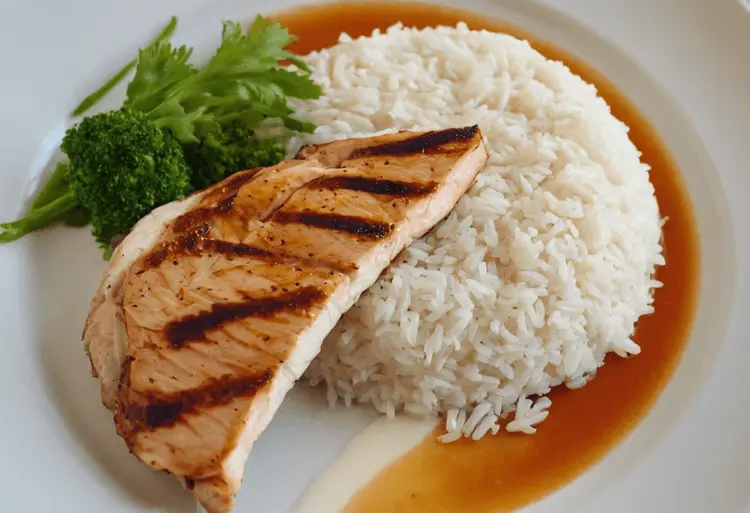The white diet might just be the answer you’ve been searching for. This short-term elimination diet focuses on bland, white-colored foods, like rice, potatoes, and chicken, to help pinpoint food sensitivities.
Unlike restrictive fad diets, the white diet isn’t about weight loss. It’s a tool for uncovering the culprits behind your digestive woes or other allergy-like symptoms.
By temporarily eliminating potential triggers, you can systematically reintroduce foods and identify those that don’t agree with you.
This low-residue diet isn’t a long-term solution, but rather a stepping stone towards better digestive health. Think of it as a detective mission for your gut!
Ready to unmask your food sensitivities? Let’s dive into the world of the white diet and explore how it can help you achieve greater well-being.
White Diet in a Nutshell:
- Temporary tool
- Identifies sensitivities
- Bland, white foods
- Not for weight loss
- Guided reintroduction
Table of contents
The “White Diet”: Demystified

Ever heard of the “white diet”? It might conjure up images of bland, boring meals, but there’s more to it than meets the eye.
What exactly is the “white diet”?
It’s not a new fad for weight loss, but rather a tool sometimes used to help identify food sensitivities or intolerances. In fact, it’s a type of elimination diet where you temporarily avoid certain foods to see how your body reacts.
However, it’s crucial to understand that the “white diet” isn’t a magic bullet or a long-term solution for healthy eating. Before embarking on any dietary changes, it’s essential to consult with a healthcare professional or registered dietitian.
They can guide you through the process, ensuring it’s safe and appropriate for your individual needs. To learn more about elimination diets and how they work, you can check out this helpful resource from the Academy of Nutrition and Dietetics.
So, what’s on the menu?
The “white diet” focuses on – you guessed it – white-colored foods. This typically includes refined grains like white rice, pasta, and bread, along with some starchy vegetables like potatoes (without the skin).
Lean protein sources like chicken and fish are also allowed, as are certain dairy products like milk and yogurt.
What’s off the table?
Colorful fruits and vegetables, whole grains, nuts, seeds, spices, and processed foods are all no-nos on this diet. These foods often contain compounds that can trigger sensitivities in some people.
How does the “white diet” work?
By temporarily eliminating potential trigger foods, you can observe how your body responds. If your symptoms improve during the elimination phase, it might indicate a sensitivity to one or more of the eliminated foods.
A registered dietitian can help you determine if the “white diet” is right for you.
Now that we’ve covered the basics, let’s dive deeper into the potential benefits and drawbacks of the “white diet.” Stay tuned for Part 2!
And don’t forget to share your thoughts and experiences in the comments below! Have you tried this diet? What were your results? We’d love to hear from you.
Cracking the code of the white diet? Great! Now, let’s spice things up. Ready to transform bland into brilliant? Our “Elimination Diet Recipes Guide” is your passport to flavorful meals that nourish your body and respect your sensitivities.
Potential Benefits and Drawbacks of the White Diet
This diet is a bit like a detective, helping to identify those sneaky food culprits that might be causing your digestive distress. But, like any good detective story, there are two sides to this coin.
Potential Benefits
- Unmasking Food Sensitivities: Ever feel like certain foods just don’t agree with you? The white diet can help you play detective, narrowing down potential triggers like gluten or FODMAPs.
- Taming Digestive Troubles: For some people, the white diet can offer sweet relief from symptoms like bloating, gas, or abdominal pain.
- Meal Planning Made Simple: Let’s face it, sometimes we crave simplicity. This diet, with its limited food choices, can make meal planning a breeze (at least temporarily).
Drawbacks: Weighing the Costs
- Nutritional Shortcomings: While “white” foods might seem harmless, they often lack essential nutrients like fiber, vitamins, and minerals. A prolonged white diet could leave you feeling less than your best.
- Not a Long-Term Solution: This diet is like a short-term investigation, not a lifelong commitment. It’s simply not sustainable for your overall health.
- The Rebound Effect: Be prepared for potential surprises when you reintroduce foods. Some people experience a return of symptoms, making it even trickier to pinpoint those food sensitivities.
Pro Tip: Remember, consult a registered dietitian to discuss if the “white diet” is appropriate for you and to learn about healthier long-term dietary approaches for managing food sensitivities.
Question: Can you lose weight on the white diet? While some people might experience initial weight loss due to the restricted nature of the diet, it’s not a healthy or sustainable way to manage your weight in the long run.
So, what are your thoughts on the white diet? Have you ever tried an elimination diet? Share your experiences in the comments below or tag us on social media!
Is the “White Diet” Right for You?
Let’s be real, the “white diet” isn’t for everyone. It’s a temporary tool, not a long-term solution.
But, the question is, is it right for you?
- Are you constantly battling unexplained digestive problems? The “white diet” might help you uncover food sensitivities.
- Do certain foods leave you feeling bloated, gassy, or just plain awful? This elimination diet could be your detective.
- Are you living with a diagnosed condition like IBS or migraines? The “white diet,” under the guidance of a healthcare professional, might be part of your management strategy.
However, let’s not sugarcoat it:
- The “white diet” lacks essential nutrients like fiber, vitamins, and minerals. It’s not a healthy long-term choice.
- You may experience rebound symptoms when reintroducing foods. This diet is a temporary investigative tool, not a lifestyle.
- Pregnant or breastfeeding women, children, adolescents, and individuals with eating disorders should steer clear. Your body has unique nutritional needs that the “white diet” simply can’t meet.
So, what’s the verdict?
- The “white diet” can be a valuable tool for identifying food sensitivities under the supervision of a healthcare professional.
- It’s NOT a magic bullet for weight loss or a sustainable eating pattern.
- Your health is unique, and your dietary needs are too.
Still have questions? Consult a registered dietitian to discuss if the “white diet” is appropriate for you and to develop a personalized plan. Remember, a well-balanced diet rich in colorful fruits, vegetables, and whole grains is the foundation of long-term health.
Implementing the “White Diet” Safely

Ready to embark on the white diet? Hold on just a second! It’s more than just eating plain foods; it’s a journey of elimination and discovery.
But how do you do it safely? Let’s break it down into manageable steps.
1: Elimination (2-3 weeks)
- Bid Farewell to Color: Wave goodbye to vibrant fruits and veggies, whole grains, and anything processed or artificially colored.
- Embrace the Bland: Stock up on allowed foods like white rice, potatoes (no skin!), plain chicken or fish, and simple dairy like milk or yogurt.
- Consult a Professional: Remember, this diet isn’t a DIY project. Partner up with a registered dietitian to ensure you’re getting the nutrients you need and to discuss any concerns. Find a registered dietitian here.
- Symptom Journal: This is your detective’s notebook! Jot down any changes in your digestion, energy levels, or overall well-being.
- Nutrients Matter: While this diet is restrictive, aim for balance. Choose lean proteins, low-fat dairy, and incorporate some healthy fats like olive oil or avocado (yes, it’s allowed!).
2: Reintroduction (Gradual and Systematic)
- One Food at a Time: After 2-3 weeks, slowly reintroduce foods you’ve eliminated, one at a time, every few days.
- Watch and Learn: Pay close attention to how your body reacts. Does that slice of tomato trigger bloating? Or does a handful of nuts cause a headache? This is where your symptom journal becomes invaluable. Learn more about elimination diets and how they work from the Academy of Nutrition and Dietetics.
- The Culprit Revealed: If a food causes a reaction, you’ve likely found a sensitivity. Consider eliminating it long-term or enjoying it in moderation.
3: Maintenance (Long-Term Dietary Adjustments)
- Your Personalized Plan: Based on your findings, create a sustainable eating plan that minimizes trigger foods while ensuring you get a wide variety of nutrients.
- Stay Mindful: Continue to listen to your body’s signals. What works for one person might not work for another.
- Seek Support: A registered dietitian can be your guide, helping you navigate this new way of eating.
This diet is a powerful tool for uncovering food sensitivities. By following these steps and working with a healthcare professional, you can make informed choices about your diet and feel your best.
Recipes and Meal Ideas for the “White Diet”
Wondering what a day on the white diet actually looks like? It’s more than just bland rice and chicken, I promise!
Breakfast:
- Creamy White Rice Porridge: A comforting start to your day. Warm, filling, and easily customizable with a sprinkle of cinnamon and a drizzle of honey. Is your sweet tooth tingling?Add some diced pear for a touch of natural sweetness.
- Scrambled Eggs with Yogurt & Chives:Light, fluffy eggs get a protein boost from plain yogurt and a savory kick from chives. Pair it with a side of gluten-free white toast for a complete meal. Feeling adventurous? Try adding a dash of white pepper for a little warmth.
Lunch:
- Chicken Salad with White Dressing: Who said salads have to be boring? Shredded chicken breast tossed with lettuce and a simple white dressing (think mayonnaise, yogurt, and lemon juice) is a refreshing midday meal. Want to add some crunch? Try diced celery or water chestnuts.
- Baked White Fish with Steamed Rice:Flaky white fish like cod or tilapia baked to perfection alongside fluffy white rice. A classic combination that’s both satisfying and gentle on digestion. Don’t forget a squeeze of lemon for a burst of flavor!
Dinner:
- Grilled Chicken with Cauliflower Rice: A healthier twist on a classic. Swap traditional rice for cauliflower rice, a low-carb, nutrient-rich alternative. Season your chicken with herbs and spices like oregano and garlic powder for a flavorful meal.
- White Bean Soup: Warm and comforting, this soup is packed with protein and fiber from white beans. Add some diced potatoes and carrots (no skin) for extra heartiness. A sprinkle of parsley adds a fresh touch.
Remember, this is just a starting point! Get creative and experiment with different flavors and textures to keep your white diet exciting.
The White Diet and Special Considerations

Navigating this diet isn’t always a one-size-fits-all journey. Have you considered how this temporary eating plan might impact people with different dietary needs or lifestyles? Let’s delve into the special considerations for specific groups:
Vegetarians and Vegans on a “White” Path?
While the classic white diet emphasizes animal protein, plant-based eaters can certainly participate. Tofu, tempeh, and white beans are excellent protein sources that fit the bill.
Don’t forget about nuts and seeds – although not “white,” they can be incorporated after the initial elimination phase if tolerated. Learn more about elimination diets and how they work from the Academy of Nutrition and Dietetics.
Athletes and Active Individuals Fueling with “White” Foods?
If you’re hitting the gym or pounding the pavement, the white diet might seem a bit bland. But it’s possible to fuel your active lifestyle with the right choices.
Focus on portion sizes and timing your meals for optimal energy. Remember, protein is crucial for muscle recovery, so make lean chicken, fish, and plant-based options a priority.
Managing Specific Conditions with the White Diet
Do you have a chronic condition like IBS or migraines? The white diet could potentially offer some relief. However, it’s crucial to consult a registered dietitian to discuss if the “white diet” is appropriate for you.
They can help you tailor the diet to your specific needs and monitor your progress.
Nutritional Information for the Health-Conscious
Even on a temporary white diet, it’s important to be mindful of your nutrient intake. Refined grains lack the fiber and nutrients of whole grains, so you might need to supplement with a multivitamin.
Be sure to choose white foods that are naturally low in sugar and sodium, such as plain yogurt and unsalted nuts.
White diet revealed some food sensitivities? Awesome! Ready to elevate your health journey? Discover the Whole30, a transformative program for lasting wellness and a vibrant relationship with food.
Your Burning Questions About the White Diet, Answered!
Navigating the world of elimination diets like the white diet can raise a lot of questions. We’re here to clear the air!
A short-term elimination diet used to identify food sensitivities, focusing on bland, white-colored foods.
White rice, pasta, bread, potatoes (no skin), chicken, fish, some dairy.
No, bananas are not allowed due to their color and potential to trigger sensitivities.
Simple meals like chicken and rice, fish with mashed potatoes, or plain pasta with white sauce are good options.
No. It’s a temporary tool for identifying food sensitivities, not a sustainable lifestyle.
Some people may, but it’s usually temporary and not necessarily healthy. Focus on balanced nutrition for lasting results.
Typically 2-3 weeks, followed by a guided reintroduction of foods. Learn more from the Academy of Nutrition and Dietetics.
Nutritional deficiencies and rebound symptoms are common. Consult a registered dietitian to discuss if this diet is appropriate for you and to ensure safe implementation.
Think plain and simple: white rice, chicken breast, potatoes (no skin), white bread, yogurt. Get creative with herbs and spices!